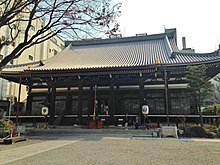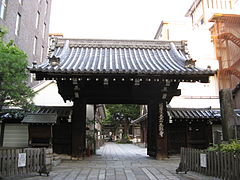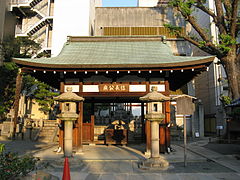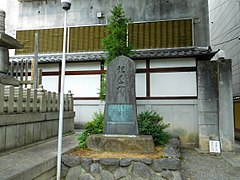Honnō-ji
The Honnō-ji ( Japanese 本能 寺 ) is a temple of Nichiren Buddhism in the city of Kyoto . The temple is best known for the Honnōji Incident - the seppuku of Oda Nobunaga forced by Akechi Mitsuhide in 1582.
history
The temple was laid out in 1415 as the main temple of the Honmon Hokke Shū , one of the oldest schools of Nichiren Buddhism, by Nichiryū ( 日 隆 ), the temple initially being written 本 応 寺 with the same reading . In 1429 he was relocated to an abandoned part of the Imperial Palace ( 内 野Uchino ) , supported by the merchant Kosodeya Sōku ( 小 袖 屋 宗 句 ) . In 1433, at the request of Nyoi Ōmaru ( 如意 王 丸 ), the name was now written as 本能 寺 and the large hexagonal hall ( 六角 大 宮Rokkaku daigū ) was built. In 1536 the temple burned down in connection with the uprising of the citizens who professed Nichiren Buddhism and was moved to Sakai . Nisshō ( 日 承 ) led the temple back to Kyōto in 1545, now to Shijō Nishi-no-tōin ( 四条 西 洞 院 ). There, in 1582, Oda Nobunaga was surprised by Akechi Mitsuhide, who was reaching for power, whereupon Nobunaga committed seppuku in a hopeless situation.
With the construction of a new temple city by Toyotomi Hideyoshi , the temple was moved to its current location. Most of the temple burned down in 1864 in connection with the uprising at the Hamaguri Gate . In the following years, however, it was gradually rebuilt.
investment
The entrance gate ( 総 門 Sōmon ), which originally belonged to Kyōmei-in ( 恭 明 院 ), was moved to its current location in 1880. - The main hall ( 本 堂 Hondō ) was rebuilt in the traditional Japanese style in 1928 by the architect Amanuma Shun'ichi ( 天 沼 俊 一 ; 1874–1947). It has an almost square floor plan with a side length of 5 × 5 Ken (9 × 9 m). It has an irimoya roof, is tiled and has a protruding roof over the entrance 3 ken (5.5 m) wide at the front.
South of the main hall are the seven "daughter temples" ( 子 院 shiin ): the Gemmyō-in ( 源 明 院 ), Hongyō-in ( 本行 院 ), Kōshun-in ( 高俊 院 ), Jōshō-in ( 定性 院) ), Renshō-in ( 蓮 承 院 ) Keishō-in ( 恵 昇 院 ) and the Ryūun-in ( 龍雲 院 ). Of these, only the latter survived the fire of 1864, the others were rebuilt between 1918 and 1928. They are each located on a plot of land 6 ken (11 m) wide, have a front of 4 ken (7 m) and a depth of 6 ken (11 m).
The Nobunaga Shrine ( 信 長 廟 Nobunaga-byō ) is on the east side of the main hall .
Treasures
Among the rich temple is a scroll that from the Heian period comes and Fujiwara no Yukinari attributed. This Fujiwara no Yukinari hitsu shokan ( 藤原 行 成 筆 書 巻 ) is registered as a national treasure. Bronze mirror ( 銅鏡 dōkyō ) from the Kamakura period , writings by Emperor Hanazono from the time of the Separate Courts are registered as important cultural assets .
photos
Remarks
- ↑ Set up in the temple city in front of the Honnō-ji.
literature
- Kyoto-fu rekishi isan kenkyukai (Ed.): Honno-ji . In: Kyoto-fu no rekishi sampo (jo) . Yamakawa Shuppan, 2011, ISBN 978-4-634-24626-3 .
Web links
- Honno-ji Incident. The Samurai Archives
Coordinates: 35 ° 0 ′ 37 ″ N , 135 ° 46 ′ 5.9 ″ E






